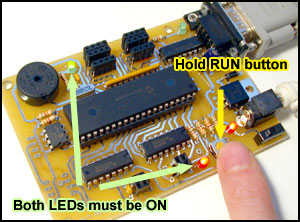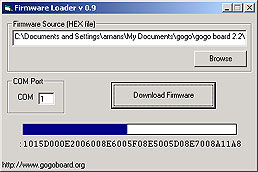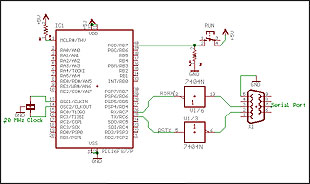GoGo Board Bootloader
(For GoGo Board 2.2 and higher)
The bootloader is a program that takes up a small portion of the PIC's
8k flash memory (the last 0.4k). The purpose of the bootloader is so
that once the bootloader is burned to the PIC, you can use it to re-program the PIC as often as you want
using only the serial port (and not the PIC burner).
You can see loaders in many consumer products (i.e. MP3 players,
CD-burners, PDAs, etc). They are normally there to allow you to upgrade
the firmware for bug fixes and performance updates. Although the GoGo
bootloader is intended for the same idea, it can be used as a general PIC
programming tool for developers as well.
Downloading a new firmware to the GoGo board
- Make sure you program the bootloader to the PIC before doing this.
See here for
more information about PIC burning.
- Connect the GoGo board to the PC's serial port.
- On the GoGo board, hold down the RUN button and power up the
board. Both the RUN and USER LEDs should light up. The board should
not beep. If this does not happen, your GoGo board may not have the
Bootloader installed.

- On your PC, download and install the Firmware Downloader software (from
the download box in this page). Then, run it.

- Open a firmware source file (HEX file) by pressing the "Browse" button.
The latest GoGo board 2.x firmware can be found on the download page.
- Make sure the COM port number corresponds to the one connected to
the GoGo board.
- Click the "Download Firmware" button. You should see the download
progress and a confirmation message once the download is complete.
Information for Developers
This section contains some info for those who want to use the
bootloader with other PIC projects. I've only tested it with the 16F877
chip. Minor modifications to the source should make it to work with
other PICs as well.
Features:
- Requires only a normal serial connection to the PIC (3 wires: Tx,
Rx, Gnd).
- Comes with a simple firmware downloader program. Source code is
available.
- The bootloader takes up only 0.4k of the PIC flash memory
(addresses from 0x1E50-0x1FFF).
- Written in C. Source code is available (requires CCS-C compiler).
- Should work with any HEX file generated by various compilers (CCS,
MPLAB, etc) as long as they don't overlap with the loader's memory
space (0x1E50-0x1FFF).
Limitations:
- No checksum. Assumes an error-free serial communication.
- The PIC's configuration bits cannot be changed. This is a
general limitation of any bootloader. To change the bits, you'll
have to recompile the loader's source and re-program the PIC with a
PIC programmer.
Hardware Requirements You must use the hardware UART on the
F877 (Pins C6, C7). You will also need a signal level converter, as
the RS232 signal level is different from the PIC's TTL signal. This
is typically accomplished with a MAX232 chip. But I normally cheat
by using a much cheaper HEX Inverter chip. It doesn't meet the
standards, but it works. Here's a diagram of a minimal circuit
you'll need:

[Click to enlarge] The serial Rx,
Tx pins goes through the inverter and then to the serial port connector.
The push button on pin B7 is used to activate the bootloader if pressed
during power up. You can easily change the activation pin in the source
code. Software Requirements The
GoGo bootloader requires minimal changes to your PIC code.
You must not use the bootloaders memory. This is
the address range from 0x1E50 to 0x1FFF, which is the last ~0.4k of
the 877's 8K flash memory. In CCS C you can do this by adding this
line to your code:
#ORG 0x1E50, 0x1FFF {}
Since the configuration bits cannot be programmed,
you're stuck with whatever configuration bits the bootloader uses.
So, make sure this is okay.
|
|
|
Download Firmware
Downloader |
|
PC Firmware downloader (Nov 27, 2003)
This is the PC interface for
downloading a firmware to the PIC that already contains the
bootloader.
|
|
|
Download Bootloader
Firmware |
Bootloader PIC code (Nov
27, 2003)
This is the bootloader code itself.
|
|
| |
|
Quick FAQs |
What does the GoGo
Bootloader do?
Once installed, you can change/update the board's firmware using
the built-in serial port. Without the loader, this process would
require removing the PIC micro-controller and using a special
programming hardware.If I already have
a GoGo board, how can I test if it has the bootloader installed?
You can try to activate the bootloader by
holding the run button while powering up the board. If both the
run and user LED light up without beeping then the board has the
firmware.
If my GoGo board does not have the
bootloader, can I install it?
Yes, but you need a PIC burner to do so.
My board has the bootloader, how do I
use it?
First, you normally use it only when you have a new firmware
for the GoGo board. To use the loader, connect the GoGo board to
the PC serial port. Then, activate the bootloader by holding the
RUN button down while powering up the GoGo board. Next, install
the Firmware Loader on your PC and run it. Finally, open the
firmware file (HEX file) and click "Download Firmware."
What's a firmware?
The firmware is a program that operates the GoGo board. It is
like the operating system of a PC. It sits in the micro-controller
and drives all other hardware that are around it (i.e. serial,
motor, and sensor ports).
What's the difference between a
firmware and a cricket logo program?
Cricket Logo only tells the firmware what to do. All the
actual execution is done in the firmware. In other words, you need
to have the firmware to run Cricket Logo.
Can I use the GoGo bootloader with my
other PIC projects?
Yes, the loader should work as long as your firmware does not
occupy the memory addresses between 0x1E50-0x1FFF (the last 0.4k). |
|
Related Links |
|
Free PIC16F87x
bootloader - This extremely small loader (~0.25k) works with
the 16F87x chips.
WLoader -
Another 16F877 loader. Has good explanation for developers.
CodeLoader - This
loader is also written in CCS-C. |
|

